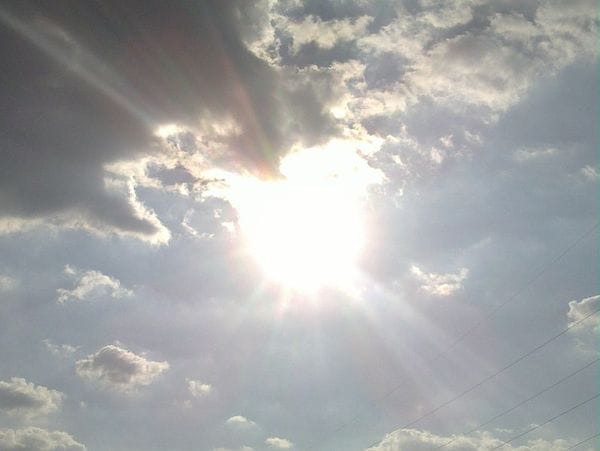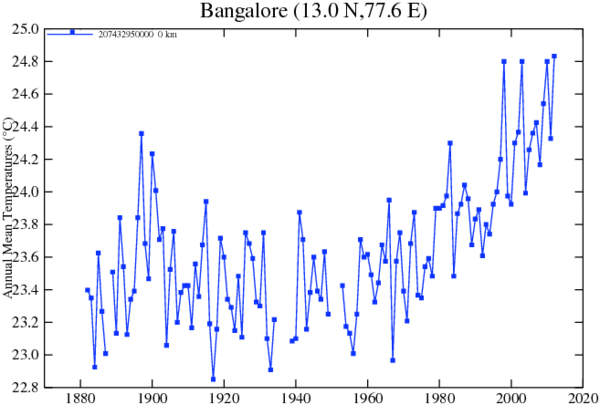The temperature in the city seems to be rising gradually over the last month. The trend is visible in the entire nation, not just limited to the city or state. While experts say that this has happened gradually over the years, Bangaloreans feel that it is rising at a more drastic pace.
Richa Anantha, a sales-woman, livng in Nagarbhavi, points that riders on the city roads can feel the sticky uncomfortable heat. The wind is not cooling. She feels that Bangalore is hotter than what it was last year.

Pic: Parvathisri via wikimedia
BV Khare, a Bangalore-based retired teacher, residing in Basaveshwaranagar, recalls that during the early 80’s, while the temperature would be around 30 degree Celsius in the afternoon, rainfall would occur in the evenings.
According to the officials from the Indian Meteorological Department, though the winter season ended in February, the city recorded a temperature two degree above normal, as opposed to the normal 30 degree Celsius for the month of February, for the year 2013.
WEATHER COMPARISON – FEBRUARY
| Year | Temperature (‘C) | Rainfall (mm) | ||
|
Highest (Date) |
Lowest (Date) |
24 Hours Highest (Date) |
Monthly Total | |
| 2012 | 35.4(29) | 14.0(02) | 0.0 | 0.0 |
| 2011 | 32.2(18) | 14.0(10) | 22.9(22) | 44.1 |
| 2010 | 34.4(19) | 14.3(5) | Trace(27) | Trace |
| 2009 | 35.2(27) | 15.3(1) | 0.0 | 0.0 |
| 2008 | 33.1(26) | 16.0(28) | 9.6(10) | 19.5 |
| 2007 | 33.8(27) | 13.7(24) | 0.0 | 0.0 |
| 2006 | 34.1(18) | 12.3(13) | 0.0 | 0.0 |
| 2005 | 35.9(17) | 14.3(8) | 7.7(2) | 7.7 |
| 2004 | 34.1(29) | 15.1(13,16) | 1.6(1) | 1.6 |
| 2003 | 33.2(22) | 16.9(8,9) | 1.8(26) | 1.8 |
| All time record | 35.9(17/2005) | 9.4(6/1884) | 67.3(22/1901) | 89.9(1932) |
The IMD officials point out that the temperatures are likely to rise further in the coming days. “This is a transition time, where winter is ending and summer is starting. The summer temperature is gradually increasing. A few weeks ago, with the presence of cloud cover, minimum temperatures had increased. Now as the cloud cover has receded, minimum temperatures have decreased. In the coming days, the temperatures will be above normal,” said IMD-Bangalore director-in-charge B Puttanna.
He added that in the third week of February, the city and the entire state recorded excess rainfall, which is an unusual phenomenon. According to him, Bangaloreans saw no winter in the year 2013. IMD statistics reveal that till February 19, 2013, the normal rainfall in Bangalore should have been 2.9mm, but 10.2 mm was the actual rainfall – 252% more. In coastal Karnataka, there was 19.5mm rainfall, as opposed to the normal 1.1mm (1056% more). In north interior Karnataka, 7.3mm rainfall was received against the normal 3.3mm rainfall (124% more). South interior Karnataka received 10.7mm rainfall as opposed to the normal 2.9mm rainfall (267% more).

Annual average temperature in Bangalore. Courtesy: Goddard Institute for Space Studies
In the coming days, the city and the state are likely to experience high temperature, dry weather and less humidity. Temperatures are likely to dip only during April- May, when thunder activities will occur, until then it is unlikely for rainfall to occur.

Min and Max yearly temperatures. Courtesy: Pavan Srinath
It turns out that over the last century, between 1901 and 2000, minimum temperatures have been consistently rising in Bangalore at a rapid rate. However maximum temperatures (mysteriously) peaked in the 1920s and 30s, before falling again. They have been rising steadily ever since the 1940s.
It is also pertinent to note that temperatures are rising faster in Bangalore than the global average! Minimum temperatures in the city have increased by about 1.32 degrees Celsius over the last hundred years (± 0.11°C). This is about double the global average.
Trends in minimum temperatures of individual months also indicate that December, February and March are warming faster than the other months.
Climate data strongly supports the notion that winter nights are getting significantly warmer in the city – with summer nights joining in.
The faster-than-global-average rise in minimum temperatures in Bangalore could indeed be because of urbanisation, land use change, and heat island effects. But one cannot conclude for certain by looking at this data alone. Also, the built up area near someone’s home could have increased, with a corresponding loss of vegetation. Data from a weather station in the central business district of Bangalore will never be able to tell us the effect of that.
– Pavan Srinath, Founder, Know Your Climate (blog.knowyourclimate.org)
Rapid urbanisation over centuries, rapid expansion of the city, increased presence of carbon-dioxide in the atmosphere, increasing pollution, heat islands and reduction in green cover, which ultimately lead to global warming, are the reasons for the weather change, according to Puttanna.
A study conducted by the Department of Agro-meteorology, University of Agricultural Sciences, Gandhi Krishi Vignana Kendra (GKVK) proves that there has been an increase in the summer trend. Professor and the head of the Department, Prof MB Raje Gowda said that before 1990s, temperatures would start rising from March 1. However, climate change has lead to the summer season beginning in the third week of February itself. Now the winter duration has reduced and summer duration has increased, thus the number of days with maximum temperature (36-37 degree Celsius) has increased as compared to earlier where it would be just for a day or two.
Gowda predicts that the pre-monsoon showers are also likely to get advanced. Earlier the pre-monsoon showers would occur during the third week of March, as per the last 7-10 years data.
Raje Gowda too says that the atmospheric pollution is the reason behind the change in season pattern. Their study has found that when temperatures over a decade are compared, the maximum temperature for winter has increased by almost 1.5 degree Celsius. So far, people experienced the maximum temperatures of summer during April-May, but now it is being experienced during February and March. However, while there may not be a continuous increase in maximum temperatures, it is likely to remain constant for a longer number of days. For instance the temperatures might not rise to 38-39 degree Celsius, but the number of days where it will remain at 37 degree Celsius would be more.
Sakshi, a young student , residing in Basaveshwaranagar, feels that the constant growth of the city causes the temperature to rise. The hotter it gets, more ACs are used, which in turn causes more heat with island effects and affects the ozone layer, which is a never-ending vicious circle.⊕